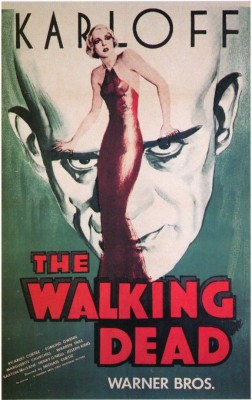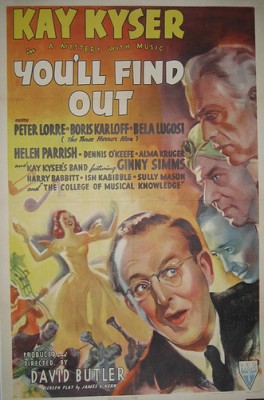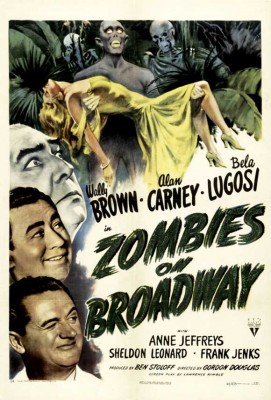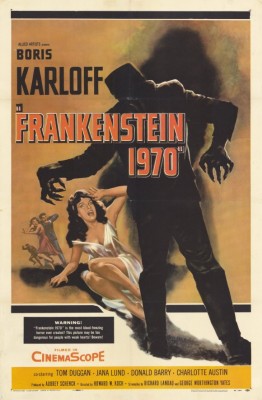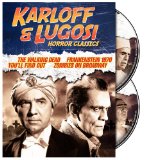| Reviews & Columns |
|
Reviews DVD TV on DVD Blu-ray 4K UHD International DVDs In Theaters Reviews by Studio Video Games Features Collector Series DVDs Easter Egg Database Interviews DVD Talk Radio Feature Articles Columns Anime Talk DVD Savant Horror DVDs The M.O.D. Squad Art House HD Talk Silent DVD
|
DVD Talk Forum |
|
|
| Resources |
|
DVD Price Search Customer Service #'s RCE Info Links |
|
Columns
|
|
|
Karloff & Lugosi Horror Classics (The Walking Dead / You'll Find Out / Zombies on Broadway / Frankenstein 1970)
The presentations look just fine and, better still, The Walking Dead and Frankenstein 1970 feature outstanding audio commentaries which are enormously fun and crammed with information. These days this reviewer rarely sticks through such things all the way through but I didn't want these to end.
The Walking Dead was produced at the tail end of the horror genre's "First Cycle" (1931-36), a period that included such classic films as Dracula (1931), The Invisible Man, Island of Lost Souls (both 1933), Bride of Frankenstein, and Mad Love (both 1935). The British ban on horror films in 1937 ground the genre to a halt for several years, which was unfortunate as Karloff gave some of his best performances just prior to the ban, including memorable work in such lesser-known films as The Black Room (1935), The Man Who Changed His Mind (1936) and, yes, The Walking Dead.
Three racketeers - Loder (Barton MacLane), Merritt (Robert Strange), and Blackstone (Paul Harvey) - along with their mouthpiece, high-powered attorney Nolan (Ricardo Cortez, second-billed), need a fall guy as they plan the murder of an incorruptible judge. They choose John Ellman (Karloff) - a one-time musician newly released from prison and now on the cusp of vagrancy because of the Depression and prejudices against ex-cons.
A desperate, highly sympathetic Ellman is set-up to take the fall and in no time the hapless patsy - with Nolan "defending" him in court, no less - is convicted and sentenced to the electric chair. Jimmy (Warren Hull) and his girlfriend, Nancy (Marguerite Churchill), an assistant to esteemed scientist Dr. Evan Beaumont (Edmund Gwenn), had witnessed the racketeers planting the judge's body in Ellman's car, but are intimidated by the gangsters to keep quiet until it's too late. However, Beaumont - anxious to learn the mysteries of life after death - legally obtains Ellman's corpse and manages the impossible: he brings the wrongly condemned man back to life. But will Ellman seek vengeance on those who sent him to the chair?
The German Expressionist-influenced Universal style of horror film and the brassy, working-class gangster movies that were Warner Bros.' stock-in-trade would seem incompatible but The Walking Dead proves to be one of the best-ever genre hybrids. The main reasons for its success are Karloff's performance and the writers' unusual approach to his character - an approach surprisingly rare in horror cinema.
When Ellman is brought back from the dead Karloff's features undergo a physical metamorphosis: his hair, close-cropped for his execution, grows back with a prominent white streak, as if the surge of electricity zapped away all its color. But Karloff extends this concept all the way down one side of his face, which he makes appear more or less paralyzed, like a stroke victim.
Had this been made at Universal, the revived Ellman would probably have obsessed with getting revenge on those who had wronged him and Ellman likely would have been endowed with some supernatural means to achieve it - like the ability to shoot electricity from his fingertips a la Lon Chaney Jr.'s Man Made Monster (1941).
Instead, the film implies Beaumont hasn't exactly brought Ellman back to life, as Beaumont thinks he has, but rather that Ellman is straddling two worlds but not quite existing in either one: the world of the living and the world of the dead. Instead of single-minded vengeance, the course such pictures usually take, Ellman's supernatural ability to locate and confront the racketeers is more like a ghostly haunting. Instead of a vengeful Frankenstein's Monster, Ellman is more like a sympathetic apparition - in effect an avenging angel meting out cosmic justice.*
Other aspects of the film are routine but well done - the film cost just $217,000. It's amusing to consider, as Gregg Mank does in his commentary, that the film is a horror-gangster movie helmed by the director of Casablanca (Michael Curtiz) featuring a villain who was once top-billed over Garbo (Cortez) and the man beloved for his performance as Santa Claus (Gwenn). All give good performances and the picture is tautly directed boasting especially effective, stylized lighting. (**** out of *****)
Prof. Fenninger (Peter Lorre): Who is this fellow, Kyser?
Judge Mainwaring (Boris Karloff): [contemptuously] Some bandleader.
General audiences back in 1940 probably had a swell time watching You'll Find Out, which is much more a vehicle for bandleader Kay Kyser and his Kollege of Musical Knowledge (including such personalities as Harry Babbitt and Ish Kabibble**, whose dorky hairstyle inspired Jim Carrey's look in Dumb and Dumber) than a showcase for its three horror stars, and more like an expanded radio show than a mystery spoof. Kyser was a big star on NBC Radio, and at the time the top personalities from that medium frequently appeared in thinly expanded film versions of their popular radio shows, partly because there was a pre-sold audience out there curious to see what their favorite radio stars looked like.
Today, however, there's not much interest watching Kyser snooping around a spooky mansion with co-star Dennis O'Keefe (as Kay's business manager) or listening to singer Harry Babbitt croon to a gaggle of debutantes, especially when these scenes come at the expense of horror movie icons Boris Karloff, Bela Lugosi, and Peter Lorre, whose footage is minimal in the much too long 97-minute film.
The plot, such as it is, has Kyser's band picking up a little extra money playing for rich girl Janis's (Helen Parrish) 21st birthday party at Bellacrest Manor, a remote mansion where her eccentric Aunt Margo (Alma Kruger) is mixed up with a phony spiritualist, turban-wearing Prince Saliano (Lugosi, virtually reprising his role from the Charlie Chan film The Black Camel). Saliano, it turns out, is plotting with Judge Mainwaring (Karloff) and Professor Fenninger (Lorre) to murder Janis, to prevent her from inheriting her rich aunt's fortune. (The film features a séance sequence that seems to have directly inspired the low-budget recreation found in Ed Wood's Night of the Ghouls.)
The awkward blending of genres and stars is reflected in the strange billing. Lorre, arguably the biggest of the three horror stars in 1940 (though not really a horror star per se, at least not then) gets second-billing after Kyser, but poor Bela gets a lousy fifth billing after Parrish and O'Keefe, while Karloff - clearly in the running for the number two position, gets an "and Boris Karloff" credit at the very end of the cast list, a billing quite unusual for the time.
The three stars get just enough screentime to be personalities but not characters, with Lugosi particularly wasted. Karloff and Lorre meanwhile slip, with a whiff of contempt, into the kind of menacing stock characters they fell back on in such comedies.
On the other hand, beyond his bandleader skills Kyser turns out to be a pretty good light comedian; he's certainly a better actor than bandleaders like stiff Glenn Miller, the hopeless Dorsey brothers and others who played themselves in a picture or two. Kabibble's pretty funny, too, in a kind of deadpan Jack Riley sort of way. The film offers a few other surprises: character actor Jeff Corey has one of his first film roles as Jeff Corey, radio contestant, while film buffs will enjoying spotting numerous stop-motion armatures from King Kong in Lugosi's hideout - including one of the spiders from Kong's infamously lost spider sequence. (** 1/2)
Incredibly, the horror-comedy Zombies on Broadway - what a wonderful title! - is a sequel of sorts to the haunting Val Lewton-Jacques Tourneur production I Walked with a Zombie (1943); the films share a few of the same actors, the same setting (the zombie-filled island, not Broadway), and there are a few references to the earlier film's story.
The picture stars ex-Vaudevillians Wally Brown and Alan Carney, a comedy team in the loosest sense of the term. In fact, the Pre-Fab Two never worked together before some mope at RKO decided they'd make a swell team, one to rival what were then the nation's top box-office attraction: Abbott & Costello, who at the time were also conveniently off the screen for an extended spell due to Costello's lifelong heart troubles. In most of the eight movies Brown & Carney made during 1944-46 Wally Brown, the vaguely Abbottonian member of the team, was called "Jerry Miles," while Costellian Alan Carney was named "Mike Strager." Did some writer actually think these fake monikers funnier than their real ones?
The briskly paced 68-minute film opens on Broadway, where Jerry and, uh, Mike (Brown & Carney) are working as press agents for recently retired gangster Ace Miller (Sheldon Leonard, natch). The duo has been remarkably adept at generating a lot of buzz about Ace's new nightclub, which promises an authentic zombie as its headliner. Unfortunately, zombies being in short supply on Broadway, Ace orders the two chumps to find one - or else.
Arriving at the Caribbean island of San Sebastian, they meet dancer Jean La Dance (Anne Jeffreys), whose nightclub act consists of throwing knives at unsuspecting customers and knocking beer bottles and cigars from their mouths, though they don't seem to mind. Eventually, Jerry and Mike stumble upon zombie expert Professor Renault (Bela Lugosi), who as it happens wants to turn Jean into his latest zombie creation.
The Brown & Carney movies are pretty much forgotten, dismissed as cheap Abbott & Costello knock-offs when they are discussed at all. But Brown and Carney are perfectly pleasant. In this, they're not really a comedy team performing routines but actors playing mildly-amusing characters.
Except possibly for Adventures of a Rookie (1944), the Brown & Carney films only vaguely imitate Abbott & Costello. There's a brief variation of the "moving candle" bit from Abbott & Costello's Hold That Ghost (1941), but nothing in this on the rip-off scale of, say, Laurel & Hardy's Great Guns (1941), an outrageously blatant steal of Buck Privates, released earlier that year. Brown and Carney are about the same size and shape of Abbott and Costello, but Carney's ever-smiling, genial patsy is nothing like Costello's wise-guy man-child, and Brown's wide-eyed straight man is nothing at all like Abbott's fast-talking grifter.***
The argument could even be made that Brown & Carney paved the way for Abbott & Costello's later monster-comedies. When Zombies on Broadway was made, their rivals at Universal hadn't yet "met" any of that studio's famous monsters; Hold That Ghost was their only horror-comedy up to that point, and that was more in the tradition of The Cat and the Canary.
It's interesting to see Lugosi in this. By 1945, his career in major studio pictures was just about over and he looks pretty old and tired. He'd done the mad scientist shtick forever and had recently been toiling away in no-budget programmers for Monogram and PRC, so it's nice to see him working in front of a set that cost more than $7.50 to put together. Even better, and almost shocking, is that instead of just being called upon to skulk around and act spooky (as in You'll Find Out), Lugosi actually gets to be funny in several scenes - on purpose. To wit:
Jerry: You see, we're doing some research work on zombies, and he said you could help us.
Dr. Paul Renault: The fool! I know nothing about zombies. I came here to study a strange coconut blight.
Mike: Coconut blight? (Pointing to Renault's assistant) He said it was a banana blight.
Dr. Paul Renault: Oh, Joseph is colorblind.
Joseph, incidentally, is played by actor Joseph Vitale, who seems to have been made up to at least partly suggest Boris Karloff - or maybe a rubber plantation foreman version of Karloff. Ian Wolfe and Nick Stewart are actually quite funny as an eccentric professor and a museum's janitor (where the same stuffed gorilla from You'll Find Out makes in appearance). Sir Lancelot is back singing some more Calypso music while emaciated, bug-eyed zombie man Darby Jones returns as the main menace. It's pretty funny watching him try to carry off Carney to Lugosi's lab. (***)
After a dozen-years drought, gothic horror movies were suddenly back in a big way. Universal's classic monster movies featuring Dracula, the Frankenstein Monster, the Mummy, et. al. were syndicated to television for the first time while Hammer Films' production of The Curse of Frankenstein (1957), with its comparatively explicit use of flesh and blood, became a worldwide sensation. By 1958 low-budget Hollywood producers were starting to cash in on the revival: I Was a Teenage Werewolf, Frankenstein's Daughter, and The Return of Dracula were just a few titles playing local drive-ins.
The pointlessly titled Frankenstein 1970, in no way at all futuristic, is an awkward and timid effort to revisit the grand gothic style while hedging its bets with a matter-of-fact smarminess to avoid appearing corny and old-fashioned. Typical 1950s sci-fi elements are also tossed in.
Suggested by an infamous - and infinitely creepier - Armed Forces Radio broadcast, the premise has a television crew shooting a documentary about the infamous monster and his creator at Frankenstein Castle in Germany, unaware that their reluctant, cash-strapped host, Baron Victor von Frankenstein (Karloff), has followed his famous ancestors' footsteps, and is concurrently assembling a creature in his secret underground laboratory, eventually culling the TV crew for body parts.
The film gets off to a great start, with the female star of the show, Carolyn (Jana Lund), running in terror through the fog-shrouded grounds near the castle, pursued by some horrible creature shown only from the neck down. It's a great little sequence - but it's a cheat. The TV crew's director (Don "Red" Barry, very abrasive) yells "Cut!" and it turns out to have all been staged.
Alas, the "real" monster stuff is embarrassingly bad. Frankenstein's creation (Mike Lane) is just a big guy wrapped in bandages with what looks like an upturned wastepaper basket covering his head. Intermittent scenes of Hammer-inspired shocks - close-ups of disembodied eyes, a heart, and the like - are undercut by silly concepts, such as the manner Dr Frankenstein disposes of body parts: he flushes them in a device that sounds exactly like a toilet. (The producers had intended grinding noises like a garbage disposal, but the Production Code censors wouldn't allow it.) Frankenstein's low-budget but still expansive top-secret lab even has an atomic reactor - but how'd the arthritic 70-year-old get all that stuff down there, especially since the only (secret) entrance seems to be through a narrow sarcophagus? UPS?
And then there's Karloff - boy-oh-boy there's Karloff. Though capable of great subtlety, generally the actor was of an older, grander theatrical tradition, but here Karloff goes way off the deep end with an incredibly hammy performance, hammy even by those forgiving parameters. He's less subtle than Vincent Price in Dr. Goldfoot and the Bikini Machine. Despite his reputation as a kind and generous man, Karloff's contempt for these lesser films was pretty obvious in his uncaring performances (see Universal's glossy but terrible The Climax for a prime example of this). In such cases, he usually switches to autopilot, but for some reason here he opted to play to the rear of the house.
He may have been repelled by the character's unrelentingly unpleasant nature: he's something of a pervert and possibly castrated by the Nazis, while the film makes distasteful use of Karloff's own physical decline, emphasizing his severely crippled body to contrast it with his robust creation.
And yet Frankenstein 1970 is still oddly enjoyable, mainly because nothing like it was produced before or since, it's a real anomaly and significant as the only live-action film in which Boris Karloff actually plays Frankenstein. (** 1/2...but fun-factor is *** 1/2)
Video & Audio
The three older films look great in their original full-frame aspect ratios. Zombies on Broadway is the weakest of the three but that's to be expected as most RKO original negatives apparently no longer exist. You'll Find Out actually looks better than most early-'40s RKO titles on DVD, while The Walking Dead is pleasantly sharp with good blacks. Frankenstein 1970 is a treat in its original CinemaScope, 16:9 enhanced here. The set puts two films on two single-sided, dual layered discs with limited chapter stops. English subtitles are included and the Dolby Digital mono is fine on all four films.
Extra Features
The two commentary tracks are just wonderful. Greg Mank's track for The Walking Dead is well researched; he obviously made extensive use of the USC-Warner Bros. Archives and probably material at the Academy of Motion Pictures Arts & Sciences Library. It's packed with detailed information and good observations. In between all the screen-specific commentary Mank slips in some appropriate, even touching personal comments.
The commentary on Frankenstein 1970 is like one big party. Historian Tom Weaver packs a lot of information about the film's production, while monster fan Bob Burns reminisces about meeting Karloff and seeing the film when it was new, and co-star Charlotte Austin (who gives the film's only good performance as the crew's beleaguered script supervisor) remembers her co-stars and the whirlwind, 8-day shoot. There's a lot of infectious laughter and fun with this track, and I really liked how Weaver gets everyone into the act, prompting Burns and Austin to read from the film's script and ballyhoo pages. (They also point out that the film's set dressing includes one of Hollywood history's all-time great movie props, which makes a cameo appearance about three-quarters of the way through the picture. Can you spot it?)
Trailers for Frankenstein 1970 and You'll Find Out round out of the package.
Parting Thoughts
Except for The Walking Dead, these are pretty much also-rans, third- and fourth-tier horror titles being released now because all the best stuff has been out on DVD for years. That hardly matters to genre fans, for whom this release surely is one of the year's highlights. And so, for them, this is Highly Recommended.
* Sergei Hasenecz makes a convincing argument that the character "isn't the one meting out justice. He is confronting his murderers, but they all die by their own terror (for which read 'conscience')....During one of these 'hauntings' Karloff looks visibly distressed when the murderer falls out the window. From a religious angle, and the movie does have this aspect, I cannot help but wonder if Karloff is hoping for the man to ask forgiveness for what he has done, and that this might also have changed the outcome and saved the man's life. It is not Karloff who is meting out justice here but, it is implied, a vengeful God. Most interestingly, this Old Testament God is roused to vengeance only because a scientific experiment has restored the dead to life. The horror/science fiction cliché 'there are things man was not meant to know' is no cliché here. The Walking Dead raises troubling questions. This is only one example of the depths of this movie."
**Once while driving through West Los Angeles (or was it Marina Del Rey?) I was surprised to pass a modest ranch house with the name "Ish Kabibble" painted on the mailbox. Must have been.
***Carney also gets points for maintaining his composure in one scene where, his character lying unconscious in a newly-dug grave, two heavy clumps of earth are from a height of at least six feet dumped right on his crotch.
Stuart Galbraith IV's latest audio commentary, part of AnimEigo's forthcoming Tora-san DVD boxed set, is available for pre-order, while his latest book, Japanese Cinema, is in bookstores now.
|
| Popular Reviews |
| Sponsored Links |
|
|
| Sponsored Links |
|
|
| Release List | Reviews | Shop | Newsletter | Forum | DVD Giveaways | Blu-Ray | Advertise |
|
Copyright 2024 DVDTalk.com All Rights Reserved. Legal Info, Privacy Policy, Terms of Use,
Manage Preferences,
Your Privacy Choices | |||||||









